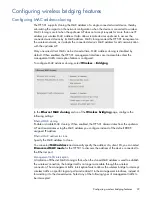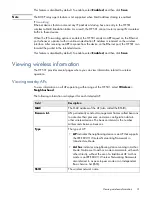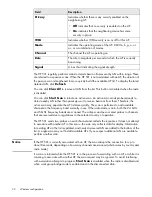
24
Wireless configuration
If multiple APs are detected with a stronger signal, preference is given to APs in the 5 GHz
band over those in the 2.4 GHz band. The detected strength of each 5 GHz AP is increased
by 10 dBm for comparison purposes only. The following examples illustrate the decision
process and assume that the
Mode
is set to
Auto
.
•
If the HP 501 is currently connected to a 5 GHz AP and the Roam delta is set to 15 dBm,
when a signal is detected that falls below the Roam threshold:
•
The HP 501 will associate with a detected 2.4 GHz AP only if its signal is more than
25 dB stronger than the current AP. Although the Roam delta is only 15 dB, when
comparing signal strengths, an additional 10 dB is added to the signal strength of the
current 5 GHz AP but not to the signal from the 2.4 GHz AP.
•
The HP 501will associate with another 5 GHz AP if its signal is more than 15 dBm
stronger than the current AP, as both APs receive the 10 dB increase.
•
If the HP 501 is currently associated with a 2.4 GHz AP, and the Roam delta is set to
10 dBm, when a signal is detected that falls below the Roam threshold:
•
The HP 501 will associate with a detected 5 GHz AP if its signal is at least 1 dB
stronger than the current AP.
•
The HP 501 will associate with another 2.4 GHz AP if its signal is more than 10 dB
stronger than the current AP, as neither AP receives the 10 dB increase.
You can specify a Roam threshold value from –99 to –1 dBm. The default is –75 dBm. You can
specify a Roam delta from 0 to 100 dBm. The default is 10 dBm.
Tip
HP recommends that network administrators experiment with these values to determine the
optimum roaming performance in your specific environment.
Notice
Setting the roam threshold too high can degrade performance.
Fragmentation threshold
Specify a number from 256 to 2,346 (even numbers only) to set the frame size threshold in
bytes. The default is 2,346 bytes.
The fragmentation threshold is a way of limiting the size of frames transmitted over the network.
If a frame exceeds the fragmentation threshold you set, the fragmentation function is activated
and the frame is sent as multiple 802.11 frames.
If the frame being transmitted is equal to or less than the threshold, fragmentation is not used.
Setting the threshold to the largest value (2,346 bytes) effectively disables fragmentation.
Fragmentation involves more overhead because it requires the extra work of dividing up and
reassembling frames and it increases message traffic on the network. However, fragmentation
can help improve network performance and reliability if properly configured.
Sending smaller frames (by using lower fragmentation threshold) might help with some
interference problems; for example, with microwave ovens.
By default, fragmentation is off. HP recommends that you not use fragmentation unless you
suspect radio interference. The additional headers applied to each fragment increase the
overhead on the network and can greatly reduce throughput.
Summary of Contents for Pavilion 501
Page 19: ...Setting the system time 19 ...
















































